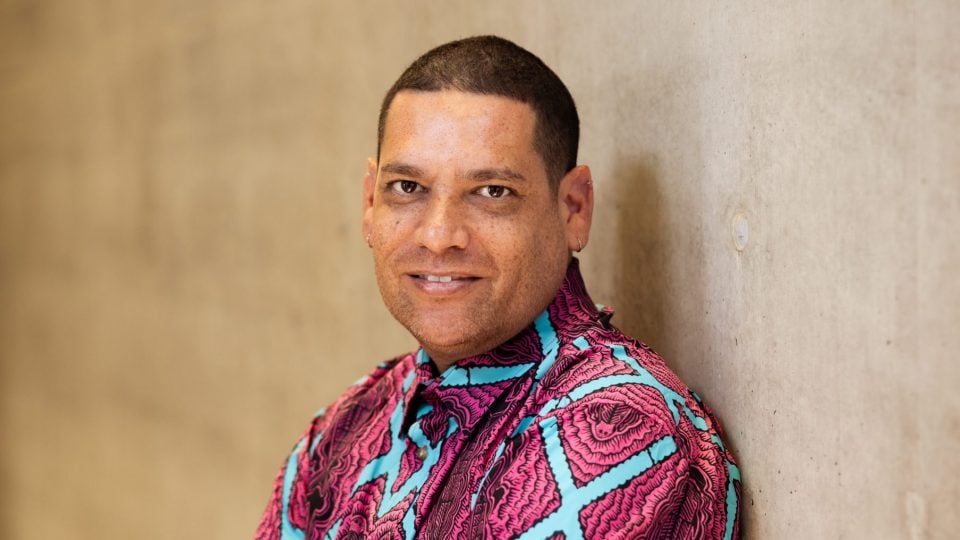Photo by Daniel Boud.
14 September 2023
The Biennale of Sydney and the Fondation Cartier pour l’art contemporain have announced a creative partnership to promote First Nations art, establishing the role of Fondation Cartier pour l’art contemporain First Nations Curatorial Fellow, with celebrated artist Tony Albert as the inaugural appointment.
As a Visionary Partner, Fondation Cartier pour l’art contemporain will work with the Biennale of Sydney in a transformative multi-project partnership from 2023 to 2027, including the 24th Biennale of Sydney (9 March – 10 June 2024) and the 25th edition in 2026. For the upcoming edition Ten Thousand Suns, the Fondation Cartier pour l’art contemporain will commission 14 new works by First Nations artists, with details to be released later this year.
A Kuku Yalanji man, Tony Albert is considered one of Australia’s foremost contemporary artists, and has gained international acclaim for his exploration of the legacy of racial and cultural misrepresentation, particularly of Australia’s Aboriginal people. Working across a diverse practice which combines text, video, drawing, painting and three-dimensional objects, Albert has developed a universal language that seeks to challenge and rewrite historical mistruths and injustice. He is recognised for his significant contributions to the arts and is acknowledged industry wide as a valued ambassador for Indigenous community and culture. Albert‘s artwork Healing Land, Remembering Country, was exhibited in NIRIN: the 22nd Biennale of Sydney (2020).
In 2023, Albert assumes the role of the Fondation Cartier pour l’art contemporain First Nations Curatorial Fellow, where he will work closely with 14 commissioned artists, bringing their creative visions to life while also forging a significant connection between the Fondation Cartier pour l’art contemporain collection in Paris and First Nations artists and curators and will contribute to the sustainable support and promotion of Indigenous art and culture in the Biennale of Sydney.
Tony Albert Biography
Tony Albert is one of Australia’s foremost contemporary artists with a longstanding interest in the cultural misrepresentation of Aboriginal people. Drawing on both personal and collective histories, his multidisciplinary practice considers the ways in which optimism might be utilised to overcome adversity. His work poses crucial questions such as ‘how do we remember, give justice to, and rewrite complex and traumatic histories?’
Albert is the first Indigenous Trustee for the Art Gallery of New South Wales. His commitment to connecting and collaborating with other artists has made him an integral part of Australia’s contemporary arts community.
2022 was a momentous year for the artist with three major public art commissions announced including a monumental 15-metre-long floating botanical sculpture, Inhabitant, which will welcome visitors at the entrance of the transformed Queen’s Wharf in Brisbane; The Big Hose, an iconic outdoor play sculpture for QAGOMA which is being made in collaboration with artist Nell and Murmurations, a collaboration with Angela Tiatia for the Museum of History NSW, Hyde Park Barracks. Albert’s major commission for the new Allianz Sydney Football Stadium, a culturally informed design and artwork for the stadium seats was also unveiled in 2022.
Albert’s major installation Healing Land, Remembering Country was unveiled at the 2020 Biennale of Sydney. In 2019 Carriageworks presented a major five metre high sculpture, House of Discards, commissioned for The National 2019: New Australian Art. In the same year Albert was commissioned by The National Gallery of Australia to deliver a significant illuminated public artwork, I am Visible. In 2013 Albert was commissioned by the City of Sydney to create an artwork for the Sydney Hyde Park War Memorial, installed in Hyde Park South on Anzac Day 2015 to commemorate indigenous soldiers.
Albert is strongly represented in major national collections including the National Gallery of Australia; the Australian War Memorial, Canberra; the Art Gallery of New South Wales; the Art Gallery of Western Australia and Brisbane’s Gallery of Modern Art—Queensland Art Gallery.
